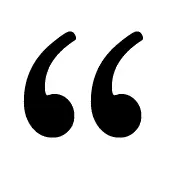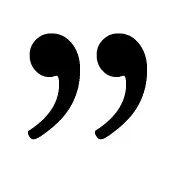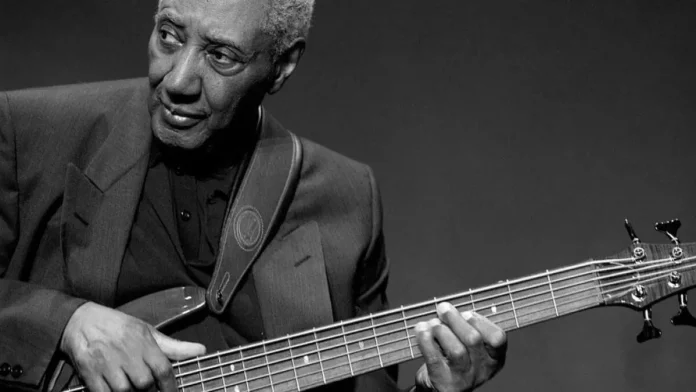When Art Blakey’s Jazz Messengers toured Britain in company with the Thelonious Monk Quartet last year, little was said about the playing of bassist Jymie Merritt. However, his solid contribution to the rhythmic pulse of the Messengers must have been noticeable to all and his musicianly, swinging work was certainly not overshadowed by Blakey’s explosively exciting drumming.
Mr. Merritt has had an interesting career in jazz. During the course of a hectic interview on the band bus which took place early in May 1961 when the band played weekend concerts in London, he talked freely of his experiences and ideas. His story is set out below as told to me. Merritt was born on May 3rd, 1926 in Philadelphia, Pennsylvania. Today, he lives with his family in New York City when not on tour with the Messengers.

My mother was the musical influence in the family. She had been a child prodigy, performing as a pianist at the age of five. She could read and write music and was particularly interested in choral work. She was with Marian Anderson at one time. She played classical music all the time at home and I used to go to sleep listening to Mozart. She taught music in the public schools and knew many professional musicians but was always sceptical about music as a profession. I was taught to read music and sing. At the weekend we usually sat down and listened to the classics. My father was in business and I think that he hoped that I would take over some day.
Fortunately, I had an uncle who was interested in jazz; about 1936, I started to listen to radio with him. I caught Count Basie’s first broadcast from Kansas City, when John Hammond was involved. An aunt collected Ellington records and after hearing those, I followed Basie and Ellington all the time, catching every broadcast. I listened to them all, Hines, Barnet and Goodman as well. I started to play a little piano and through music appreciation classes at school, began also to be interested in the harmonic aspects of Schoenberg, Berg and Debussy. My mother tried to steer me away from jazz, of course.
‘Composers outside of jazz still interested me and it seemed that modern jazz was beginning to tie up the two sides’
I went into the Army in 1943 and spent two years in Italy. I played clarinet and saxophone in the Army for my own amusement. There were some fine musicians in the Service but none I can remember by name now. We listened to the Voice of America and that way kept up with the developments in jazz. We first heard Parker and Gillespie that way and I began to make a decision about modern jazz. When I left the Army, I entered the Orenstein School of Music in Philadelphia under the G.I. Bill of Rights. Composers outside of jazz still interested me and it seemed that modern jazz was beginning to tie up the two sides. So I made up my mind to go into it actively.
Leo Orenstein was a concert composer originally from Russia. At his school, I studied theory; my main interest at that time was to see if there was any co-relation between jazz and classical music. I became somewhat disillusioned as there was this element of disconcern as far as the jazz idiom was concerned. You had to look far and long before you could find anybody who had training in classics and an interest in jazz. I kept on looking and finally ran into a system of study called the Schillinger System of Musical Composition. I dropped the Orenstein studies and went to study with Clarence Cox at the Hamilton School of Music (now the Holmes school). I had approached several people at the Orenstein School to teach the system but there was not the least bit of interest. Cox is teaching today at the Orenstein School (now the Cone’s Conservatory of Music) that I quit to go with him! The Philadelphia Conservatory of Music put me to some sort of test; they supervised to see that time was not being wasted.
As a result of my tenure in service I had a chronic sinus condition; I’d been sleeping on the ground most of the time and it got so bad it was affecting my whole breathing so I switched instruments. The clarinet became too difficult and I was not prepared to tackle the piano so the bass came instead.
I hadn’t been interested in participating on the level that was available before I went in the Service but when I came back, Gillespie and Parker were being heard more and these were the guys that I started to follow then. The big bands were practically out. Inspired by the new music, I started playing around the Philadelphia area but not on a professional basis. I just sought out about everybody I could, fellows like John Coltrane, Jimmy Heath (now back in Philly and doing well), Specs Wright (drummer with Dizzy for a good while), Benny Golson and some others that didn’t make it but could have. Out of these private sessions, I began to get invitations to play out publicly, some of which I accepted; a few night club dates and so on, just for experience. Finally some time in 1949 or early 1950, I got a call from Benny Golson. He was working in the band of a fellow by the name of Bull Moose Jackson and they needed a bass player.
The personnel of the band was Philly Joe Jones on drums, pianist Tadd Dameron who was doing all the writing, Johnny Coles, trumpet player, recording right now with Gil Evans, and alto man Snooky Hulbert, formerly with the old Lunceford band. He was a virtuoso on his instrument and the swing influence in the band. This band was together for about three years with a few personnel changes, like John Coltrane coming in when Benny Golson left.
Prior to joining Jackson I was still studying; I had worked out of town on engagements but this was to be my first experience of touring. We went all through the South, playing dances. The group was definitely modern because Tadd was doing the writing and the only things that we played that could be considered Rhythm ‘n’ Blues, and they were more in the popular idiom, were the songs that Bull Moose did. They were on a more or less contrived level with scores by fellows from New York, the type used in the studios. I had an opportunity later to work with what I call Rhythm ‘n’ Blues artists. Other than that, we played either Tadd’s or Benny’s tunes.
Police reaction when Tadd Dameron drank at a Florida water fountain in the early 1950s: ‘Hey you, that fountain’s not for you, move on, otherwise I’ll use this gun’
Down South, we played practically all coloured dances. As for discrimination, I can remember one famous incident that sticks in my mind. We were coming up from Florida Keys to Miami and Tadd had been driving all the way; it was one of those arid days and he was dry and jumped out of the car to go get a drink of water at the fountain at this petrol station. This was ridiculous, because here was a man just taking a drink of water out of a fountain and all of a sudden, we heard a siren screaming, and turning round, there’s this police car bearing down on us, a great red light turning on the top. This guy jumps over the running board with a gun in his hand and shouts out, “Hey you, that fountain’s not for you, move on, otherwise I’ll use this gun.”
The band eventually changed altogether and I left around early 1953. I went back home to Philadelphia and started to study again, while freelancing round town. I joined a group backing up the visiting bands and stars; the others were Red Garland, piano, and Charlie Rice, drums. I have to mention Charlie; he’s one of my favourite drummers as far as time is concerned. He has a conception that reminds me of Kenny Clarke and Denzil Best. We backed people like Stuff Smith, Roy Eldridge and Milt Jackson, as house band.
‘On the bass, the main influences were Jimmy Blanton, Oscar Pettiford and Ray Brown’
On the bass, the main influences were Jimmy Blanton, Oscar Pettiford and Ray Brown; as for Blanton, I haven’t heard anyone yet come along with as much command, with possibly the exception of Ray. I have never tried to emulate these players as such, no matter how much I might be impressed by what they were doing. There’s a tremendous temptation in jazz to emulate but if a thing does not come to me through a process of my own realization, I cannot do it. You’re using your ears so much that it’s done almost slavishly until somebody comes along with sufficient command to attract the younger generation and at the same time, to teach them.
Still in Philadelphia, in the summer of 1953, Tadd Dameron organised a full size band for a revue entitled ‘Tropicana’, that was opening in Atlantic City. We played the show and also appeared as a feature. Some of the guys in the band were Clifford Brown, Johnny Coles, trumpets, Jay Jay Johnson, trombone, Benny Golson, Gigi Gryce, (both writing), Hank Mobley, Cecil Payne, saxes and Philly Joe Jones, drums. There were a few changes, some of the guys like Cecil Payne left to go on the road with other bands. Brownie left to go to Europe with Hamp. At the end of the summer, the band was leaderless, narcotics addiction having caused the incarceration.
Later on that year, I was getting ready to go over to a club in Baltimore, same sort of thing I had done in Philadelphia.
They had a policy of bringing in names and I went down there for several weeks with Eddie Davis and Sonny Stitt and just about the time Bird was due to come in, I got a call from a fellow by the name of Chris Powell who Brownie had worked for in 1952-53, to join his band.
‘I tried a Fender electric bass and that night I took it to work. The owner let me take it and I tried it out working and nobody raised any objection . . . I played it for the next seven years or so. I guess at the time I was the only one in jazz playing an electric bass’
Now all this time, I had been playing electric bass, from about the first year of service with the Bull Moose band. We were out in Oklahoma somewhere, when Benny Golson saw this Western band, what you call a hillbilly band, with a fellow playing what looked like a guitar and sounded like a bass. Benny got me over to hear this and we later saw one in a music store. Benny went in for some reeds or something, so I tried a Fender electric bass and that night I took it to work. The owner let me take it and I tried it out working and nobody raised any objection. I had been having trouble with my own bass, one of the assembly line type, so I was in the market for a new bass. Anyway, I got curious and bought the thing and played it for the next seven years or so. I guess at the time I was the only one in jazz playing an electric bass. Certainly, I’m pretty sure Monk Montgomery wasn’t playing one because we used to see him in Minneapolis and he was always interested to see the instrument.
Anyway, this fellow, Chris Powell, called me to ask if I’d be interested in playing this instrument in an entertaining group. I knew that Brownie had been with the band and I was attracted to his ideas – he was a very radical thinker. I joined and had an opportunity to sing, dance and play on an integrated basis; I had studied some new rhythms and in the two years I worked with Powell, my co-ordination became much improved. We played jazz-type lines but it was basically a novelty group. With the exception of Clifford Brown there was no one well known in the personnel. He had left to go with Max Roach after two years with Powell. We operated mainly on a creative level often using the spoken word; it was very hard work and there was a little too much non-musical material for me. One member, pianist Duke Wells, got sick and the group broke up during 1956; in fact, I was the first to leave.
I then joined a group doing the same sort of thing; interaction of all forms. This was the Romaines, led by pianist Romaine Brown. He had studied at Curtis Institute in Philadelphia and majored on viola. There was not sufficient free interplay for the individuals in this group so I left fairly quickly.
I then took up a standing invitation and joined the big band that travelled with Rhythm ‘n’ Blues singer, B. B. King. We really went into the deep South with that band, only getting home about once a year. Johnny Board, alto and tenor, Henry Boozier, trumpet, and others in the idiom were in the band. I had a chance to play with Muddy Waters and to record with many folk artists. We’d get into town and go into the studio with these guys, never knew their names, they’d play harmonica or guitar and just sing the blues. I was also on all B. B. King’s records during the period. I enjoyed working with B.B. and I always found it artistically satisfying. Still, touring was tiring and after two years, 1956-58, I returned to Philadelphia to freelance for a while.
Late in 1958, I got a call to join Art Blakey and I discarded the electric bass. I’ve been with him ever since, as you know. . .

















